

|
| DEUTSCHLAND | GERMANY |
| Bundesland: Baden-Württemberg | |
| Regierungsbezirk: Freiburg | |
| Landkreis: Konstanz |
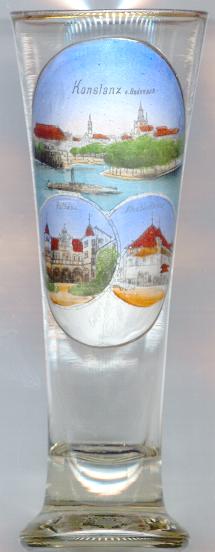 Konstanz is situated at an elevation of 394 m at the Bodensee (Lake Constance) and the river Rhine (See-Rhein), at the border between Germany and Switzerland.
A Celtic settlement existed here already in the 1st century BC.
Around 40 AD, the first Romans settled on the site. This small town on the left bank of the Rhine was probably first called Drusomagus and belonged to the
Roman province of Raetia. Its later name, originally Constantia, comes either from the Roman emperor Constantius Chlorus (Constantius I), who fought the Alemanni in the region
and built a strong fortress around 300 AD, or from his grandson Constantius II, who visited the region in 354.
In the 6th century, Konstanz became the seat of a bishop. Until 1814/27, the diocese was the largest in all the German countries. Situated at the crossroads of important
routes of commerce to upper Italy, France and eastern Europe, Konstanz became an important trading place for fur, linnen and spices.
In 1192, Konstanz obtained the status of a Free Imperial City.
During the Council of Konstanz (1414–1418) the European bishops congregated. The council was called in following a suggestion of the
German King Sigismund (Emperor in 1433) in order to end the Western Schism (pope Gregor XII, antipopes Alexander (V) and Johannes (XXIII)).
The council elected Cardinal Otto Colonna as pope Martin V in 1417.
The reformer Jan Hus was summoned to the council to defend himself, but was finally arrested and executed in 1415 (see Husinec, CZ).
The Hussite Wars, which began in 1420, only ended after the Council of Basel in 1433. The radical Hussites, the
Taborites (see Tábor, CZ), were defeated one year later. Konstanz became Protestant in 1527 and the Catholic bishops moved their
seat to Meersburg where they resided until 1821 when the bishopric was dissolved and was incorporated into the archdiocese of
Freiburg. After the victory of the Counter-Reformation in 1548, Konstanz lost its status of a Free Imperial city and became part of
Habsburg Anterior Austria (see map).
During the Napoleonic wars, Konstanz became part of the new Grand Duchy of Baden in 1806.
Konstanz is situated at an elevation of 394 m at the Bodensee (Lake Constance) and the river Rhine (See-Rhein), at the border between Germany and Switzerland.
A Celtic settlement existed here already in the 1st century BC.
Around 40 AD, the first Romans settled on the site. This small town on the left bank of the Rhine was probably first called Drusomagus and belonged to the
Roman province of Raetia. Its later name, originally Constantia, comes either from the Roman emperor Constantius Chlorus (Constantius I), who fought the Alemanni in the region
and built a strong fortress around 300 AD, or from his grandson Constantius II, who visited the region in 354.
In the 6th century, Konstanz became the seat of a bishop. Until 1814/27, the diocese was the largest in all the German countries. Situated at the crossroads of important
routes of commerce to upper Italy, France and eastern Europe, Konstanz became an important trading place for fur, linnen and spices.
In 1192, Konstanz obtained the status of a Free Imperial City.
During the Council of Konstanz (1414–1418) the European bishops congregated. The council was called in following a suggestion of the
German King Sigismund (Emperor in 1433) in order to end the Western Schism (pope Gregor XII, antipopes Alexander (V) and Johannes (XXIII)).
The council elected Cardinal Otto Colonna as pope Martin V in 1417.
The reformer Jan Hus was summoned to the council to defend himself, but was finally arrested and executed in 1415 (see Husinec, CZ).
The Hussite Wars, which began in 1420, only ended after the Council of Basel in 1433. The radical Hussites, the
Taborites (see Tábor, CZ), were defeated one year later. Konstanz became Protestant in 1527 and the Catholic bishops moved their
seat to Meersburg where they resided until 1821 when the bishopric was dissolved and was incorporated into the archdiocese of
Freiburg. After the victory of the Counter-Reformation in 1548, Konstanz lost its status of a Free Imperial city and became part of
Habsburg Anterior Austria (see map).
During the Napoleonic wars, Konstanz became part of the new Grand Duchy of Baden in 1806.
Guillaume-Henri Dufour (1787–1875), one of the founders of modern Switzerland, was born in Konstanz.
The  Rathaus (town hall) [left, no. 909: bottom left]
is a combination of several buildings dating back to the Middle Ages and the Renaissance.
Its core is the former weavers' guildhouse dating from the 16th century.
Rathaus (town hall) [left, no. 909: bottom left]
is a combination of several buildings dating back to the Middle Ages and the Renaissance.
Its core is the former weavers' guildhouse dating from the 16th century.
The catholic
(see also list of other basilicae minores depicted on glasses of this collection)
From 1526, the bishops of Konstanz resided at Meersburg. In 1814 the portion of the diocese situated on Swiss territory was detached and apportioned
to the Swiss dioceses of Chur, Basel, and St. Gallen. In 1817, the portion of the diocese
lying in Württemberg came under the jurisdiction of the vicar-general of Ellwangen-Rottenburg, and all the Bavarian territory was attached to the
Diocese of Augsburg. In 1821/27, the diocese was finally dissolved and its remaining territory joined to the newly erected
Archdiocese of Freiburg.
The
The former
The
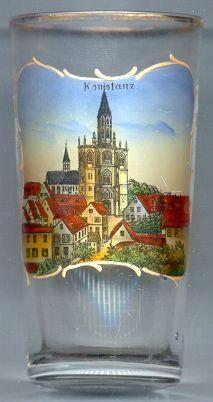 The so-called
The so-called  Konzilsgebäude [left, no. 909: bottom right]
was originally built in 1388 as a corn depot. It is not very likely that building was the actual place where the Council of Konstanz congregated,
but it may have been the place of the conclave that elected pope Martin V in November 1417. The building was modified several times
during the following centuries.
Konzilsgebäude [left, no. 909: bottom right]
was originally built in 1388 as a corn depot. It is not very likely that building was the actual place where the Council of Konstanz congregated,
but it may have been the place of the conclave that elected pope Martin V in November 1417. The building was modified several times
during the following centuries.
 Münster Unser Lieben Frau (minster church of Our Lady) [right, no. 1797]
goes back to an early cathedral church built in the 7th century on the site of the former Roman fort. The crypt dates from the 9th and 10th century.
The Maritius-Rotunde of around 940 AD is an emulation of the Holy Sepulcre. The early Gothic nave from the 13th century rests on Romanesque
monolithic pillars from the 11th century, the vaultings were completed in 1679–1683. The Neo-Gothic upper part of the west tower was added in 1853.
In 1955 the church received the papal title of a Basilica minor.
Münster Unser Lieben Frau (minster church of Our Lady) [right, no. 1797]
goes back to an early cathedral church built in the 7th century on the site of the former Roman fort. The crypt dates from the 9th and 10th century.
The Maritius-Rotunde of around 940 AD is an emulation of the Holy Sepulcre. The early Gothic nave from the 13th century rests on Romanesque
monolithic pillars from the 11th century, the vaultings were completed in 1679–1683. The Neo-Gothic upper part of the west tower was added in 1853.
In 1955 the church received the papal title of a Basilica minor.
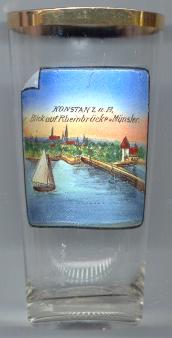
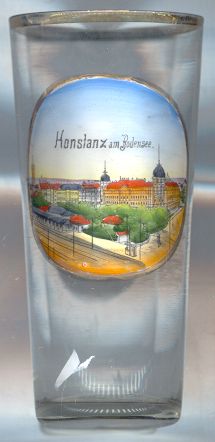
 Rheintorturm [left, no. 978: far right]
was built in the 14th/15th century as a gate tower at the site of an older bridge across the Rhine.
Rheintorturm [left, no. 978: far right]
was built in the 14th/15th century as a gate tower at the site of an older bridge across the Rhine.
 Reichspostgebäude (Imperial post office building) right, no. 1354: centre right]
was built in Neo-Renaissance style in 1888–1891. Today it is used by the Konstanz Savings Bank.
Reichspostgebäude (Imperial post office building) right, no. 1354: centre right]
was built in Neo-Renaissance style in 1888–1891. Today it is used by the Konstanz Savings Bank.
 harbour [below, no. 1178] was built in 1839–1842.
harbour [below, no. 1178] was built in 1839–1842.
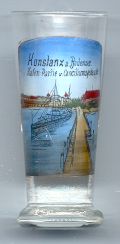
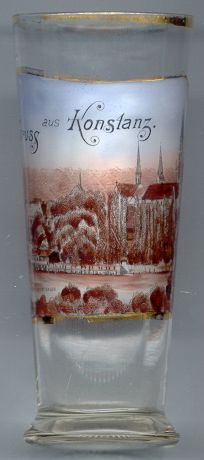
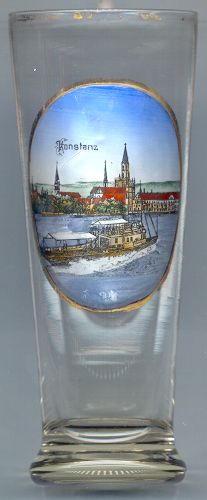
While Konstanz obtained its name either for emperor Constantius Chlorus (Constantius I) or his grandson Constantius II,
Constanța in Romania was named for Flavia Julia Constantia, half-sister of
emperor Constantine the Great.
![[scale]](lineal.jpg)